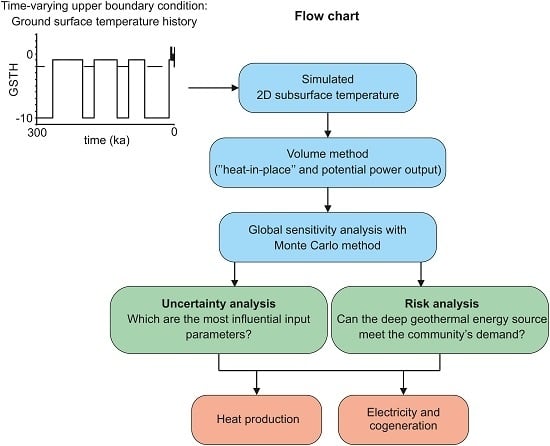Uncertainty and Risk Evaluation of Deep Geothermal Energy Source for Heat Production and Electricity Generation in Remote Northern Regions
Abstract
:1. Introduction
2. Geographic and Geological Setting
3. Materials and Methods
3.1. Thermophysical Properties
3.2. 2D Subsurface Temperature Distribution
3.3. Geothermal Energy Source and Potential Heat and Power Output
3.3.1. Volume Method
- The minimum temperature to generate electricity by a binary GPP considering an Arctic design is around 120–140 °C [60]
3.3.2. Global Sensitivity Analysis with Monte Carlo Method
- Thermophysical properties at dry conditions and warm GSTH
- Thermophysical properties at dry conditions and cold GSTH
- Thermophysical properties at water saturation conditions and warm GSTH
4. Results
4.1. Thermophysical Properties
4.2. 2D Subsurface Temperature Distribution
4.2.1. Influence of Model Mesh
4.2.2. Influence of GSTH
4.2.3. Influence of Thermophysical Properties Conditions
4.3. Geothermal Energy Source and Potential Heat and Power Output
- Which geological and technical uncertainties are the most influential input parameters?
- Can the deep geothermal energy source meet the heat/power demand in Kuujjuaq?
4.3.1. Heat Production
4.3.2. Electricity Generation
5. Discussion
5.1. Thermophysical Properties
5.2. 2D Subsurface Temperature Distribution
5.3. Geothermal Energy Source and Potential Heat and Power Output
5.4. Deep Geothermal Energy as a Viable Solution to Reduce Fossil Fuels Dependency of Remote Communities
- Is the deep geothermal energy source sufficiently abundant to meet the local heat and power demand?
- Is the deep geothermal energy source cost-competitive compared to fossil fuels?
- Will the deep geothermal energy source help to reduce or eliminate greenhouse gas emissions?
6. Conclusions
Author Contributions
Funding
Acknowledgments
Conflicts of Interest
Notation
| A | Radiogenic heat production | W m−3 |
| b, d | Experimental constants | |
| C | Radioelements concentration | mg kg−1,% |
| F | Factor | % |
| f | Function | |
| H | Thermal energy | J |
| P | Pressure | Pa |
| PO | Power output | W |
| Q | Heat flux | W m−2 |
| R | Recovery factor | % |
| T | Temperature | °C |
| t | Time | s |
| V | Volume | m3 |
| x, z | Spatial variables | m |
| Greek letters | ||
| η | Thermal efficiency | % |
| λ | Thermal conductivity | W m−1 K−1 |
| μ | Arithmetic mean | |
| ρ | Density | kg m−3 |
| ρc | Volumetric heat capacity | J m−3 K−1 |
| σ | Population standard deviation | |
| Subscript | ||
| 0 | Surface | |
| 10 | 10-km-depth | |
| 20 | Room temperature | |
| amb | Ambient | |
| dry | Dry conditions | |
| e | Electrical | |
| g | Ground | |
| GPP | Geothermal power plant | |
| K | Potassium | |
| max | Maximum | |
| min | Minimum | |
| res | Reservoir | |
| ref | Reference | |
| Th | Thorium | |
| th | Thermal | |
| U | Uranium | |
| Wet | Water-saturation conditions | |
| Abbreviations | ||
| ASTM | American Society for Testing and Materials | |
| B.P. | Before present | |
| CHP | Combined heat and power | |
| EGS | Engineered geothermal systems | |
| FEM | Finite element method | |
| GPP | Geothermal power plant | |
| GSTH | Ground surface temperature history | |
| IAEA | International Atomic Energy Agency | |
| ICP-MS | Inductively coupled plasma-mass spectrometry | |
| MIS | Marine Isotope Stage | |
| USD | US dollars | |
| USGS | United States Geological Survey | |
References
- IRENA—International Renewable Energy Agency. Off-Grid Renewable Energy Solutions to Expand Electricity Access: An Opportunity Not to Be Missed; IRENA: Abu Dhabi, UAE, 2019; 28p.
- Grasby, S.E.; Majorowicz, J.; McCune, G. Geothermal Energy Potential for Northern Communities; Open File 7350; Geological Survey of Canada: Calgary, AB, Canada, 2013; 50p. [Google Scholar] [CrossRef]
- Arriaga, M.; Brooks, M.; Moore, N. Energy access—The Canadian context. In Waterloo Global Science Initiative’s OpenAcess Energy Blueprint; Rutherford, H., Wright, J., Eds.; WGSI: Waterloo, ON, Canada, 2017; pp. 1–6. [Google Scholar]
- Rise in the Cost of Gasoline. Available online: https://www.makivik.org/rise-in-the-cost-of-gasoline/ (accessed on 6 July 2020).
- Schallenberg, J. Renewable energies in the Canary Islands: Actual situation and perspectives. In New and Renewable Technologies for Sustainable Development; Afgan, N.H., da Graça Carvalho, M., Eds.; Springer: Boston, MA, USA, 2002; pp. 233–246. [Google Scholar] [CrossRef]
- Kanase-Patil, A.B.; Saini, R.; Sharma, M. Integrated renewable energy systems for off grid rural electrification of remote area. Renew. Energy 2010, 35, 1342–1349. [Google Scholar] [CrossRef]
- Palit, D.; Chaurey, A. Off-grid rural electrification experiences from South Asia: Status and best practices. Energy Sustain. Dev. 2011, 15, 266–276. [Google Scholar] [CrossRef]
- Chmiel, Z.; Bhattacharyya, S.C. Analysis of off-grid electricity system at Isle of Eigg (Scotland): Lessons for developing countries. Renew. Energy 2015, 81, 578–588. [Google Scholar] [CrossRef] [Green Version]
- Bhattacharyya, S.C.; Palit, D. Mini-grid based off-grid electrification to enhance electricity access in developing countries: What policies may be required? Energy Policy 2016, 94, 166–178. [Google Scholar] [CrossRef] [Green Version]
- Görgen, M.A. Feasibility Study of Renewable Energy Systems for Off-Grid Islands: A Case Study Concerning Cuttyhunk Island. Master’s Thesis, University of Rhode Island, Kingston, RI, USA, 2016. [CrossRef]
- Off-Grid Renewable Energy in Africa. Available online: https://www.irena.org/-/media/Files/IRENA/Agency/Data-Statistics/Off-grid-renewable-energy-in-Africa.pdf?la=en&hash=0FEC28407B13C1A7AAD58F5AC28E295A4541EEA4 (accessed on 12 August 2020).
- International Bank for Reconstruction and Development/The World Bank. Reliable and Affordable Off-Grid Electricity Services for the Poor: Lessons from the World Bank Group Experience; The World Bank: Washington, DC, USA, 2016; 100p. [Google Scholar]
- Islam, F.M.R.; Mamun, K.A.; Amanullah, M.T.O. (Eds.) Smart Energy Grid Design for Island Countries: Challenges and Opportunities; Springer: Cham, Switzerland, 2017; 468p. [Google Scholar] [CrossRef]
- Wu, Q.; Larsen, E.; Heussen, K.; Binder, H.; Douglass, P. Remote Off-Grid Solutions for Greenland and Denmark: Using smart-grid technologies to ensure secure, reliable energy for island power systems. IEEE Electrif. Mag. 2017, 5, 64–73. [Google Scholar] [CrossRef]
- Rud, J.N.; Hørmann, M.; Hammervold, V.; Ásmundsson, R.; Georgiev, I.; Dyer, G.; Andersen, S.B.; Jessen, J.E.; Kvorning, P.; Brødsted, M.R. Energy in the West Nordics and the Arctic: Cases Studies; TemaNord 2018:539; Nordic Council of Ministers: Copenhagen, Denmark, 2018; 82p. [Google Scholar]
- Selosse, S.; Garabedian, S.; Ricci, O.; Maizi, N. The renewable energy revolution of reunion island. Renew. Sustain. Energy Rev. 2018, 89, 99–105. [Google Scholar] [CrossRef] [Green Version]
- Viteri, J.P.; Henao, F.; Cherni, J.; Dyner, I. Optimizing the insertion of renewable energy in the off-grid regions of Colombia. J. Clean. Prod. 2019, 235, 535–548. [Google Scholar] [CrossRef]
- Off-Grid Innovation Improves Thousands of Lives in Rural Peru. Available online: http://documents1.worldbank.org/curated/en/541211565721769744/pdf/Off-Grid-Innovation-Improves-Thousands-of-Lives-in-Rural-Peru.pdf (accessed on 29 July 2020).
- Ringkjøb, H.-K.; Haugan, P.M.; Nybø, A. Transitioning remote Arctic settlements to renewable energy systems—A modelling study of Longyearbyen, Svalbard. Appl. Energy 2020, 258, 114079. [Google Scholar] [CrossRef]
- Hjartarson, A.; Armannsson, H. Geothermal Research in Greenland. In Proceedings of the World Geothermal Congress, Bali, Indonesia, 25–29 April 2010. [Google Scholar]
- Majorowicz, J.A.; Grasby, S.E. Geothermal Energy for Northern Canada: Is it Economical? Nat. Resour. Res. 2013, 23, 159–173. [Google Scholar] [CrossRef]
- Midttome, K.; Jochmann, M.; Henne, I.; Wangen, M.; Thomas, P.J. Is geothermal energy an alternative for Svalbard? In Proceedings of the 3rd Sustainable Earth Sciences Conference & Exhibition, Celle, Germany, 13–15 October 2015; pp. 1–5. [Google Scholar] [CrossRef]
- Eidesgaard, Ó.R.; Schovsbo, N.H.; Boldreel, L.; Ólavsdóttir, J. Shallow geothermal energy system in fractured basalt: A case study from Kollafjørður, Faroe Islands, NE-Atlantic Ocean. Geothermics 2019, 82, 296–314. [Google Scholar] [CrossRef]
- Gascuel, V.; Bédard, K.; Comeau, F.-A.; Raymond, J.; Malo, M. Geothermal resource assessment of remote sedimentary basins with sparse data: Lessons learned from Anticosti Island, Canada. Geotherm. Energy 2020, 8, 1–32. [Google Scholar] [CrossRef]
- Franco, A.; Ponte, C. The role of geothermal in the energy transition in the Azores, Portugal. Eur. Geol. J. 2019, 47, 21–27. [Google Scholar]
- Geothermal Country Overview: The Canary Islands. Available online: https://www.geoenergymarketing.com/energy-blog/geothermal-country-overivew-the-canary-islands/ (accessed on 12 August 2020).
- Koon, R.K.; Marshall, S.; Morna, D.; McCallum, R.; Ashtine, M. A review of Caribbean geothermal energy resource potential. West Indian J. Eng. 2020, 42, 37–43. [Google Scholar]
- Rajaobelison, M.; Raymond, J.; Malo, M.; Dezayes, C. Classification of geothermal systems in Madagascar. Geotherm. Energy 2020, 8, 1–26. [Google Scholar] [CrossRef]
- Kagel, A.; Bates, D.; Gawell, K. A Guide to Geothermal Energy and the Environment; Geothermal Energy Association: Washington, DC, USA, 2005; 88p. [Google Scholar]
- Kanzari, I. Évaluation du Potentiel des Pompes à Chaleur Géothermique Pour la Communauté Nordique de Kuujjuaq. Master’s Thesis, Institut National de la Recherche Scientifique, Quebec, QC, Canada, 2019. [Google Scholar]
- Gunawan, E.; Giordano, N.; Jensson, P.; Newson, J.; Raymond, J. Alternative heating systems for northern remote communities: Techno-economic analysis of ground-coupled heat pumps in Kuujjuaq, Nunavik, Canada. Renew. Energy 2020, 147, 1540–1553. [Google Scholar] [CrossRef]
- Kinney, C.; Dehghani-Sanij, A.; Mahbaz, S.; Dusseault, M.B.; Nathwani, J.; Fraser, R.A.; Sanij, D. Geothermal Energy for Sustainable Food Production in Canada’s Remote Northern Communities. Energies 2019, 12, 4058. [Google Scholar] [CrossRef] [Green Version]
- Giordano, N.; Raymond, J. Alternative and sustainable heat production for drinking water needs in a subarctic climate (Nunavik, Canada): Borehole thermal energy storage to reduce fossil fuel dependency in off-grid communities. Appl. Energy 2019, 252, 113463. [Google Scholar] [CrossRef]
- Mahbaz, S.; Dehghani-Sanij, A.; Dusseault, M.; Nathwani, J. Enhanced and integrated geothermal systems for sustainable development of Canada’s northern communities. Sustain. Energy Technol. Assess. 2020, 37, 100565. [Google Scholar] [CrossRef]
- Tester, J.W.; Anderson, B.J.; Batchelor, A.S.; Blackwell, D.D.; DiPippo, R.; Drake, E.M.; Garnish, J.; Livesay, B.; Moore, M.C.; Nichols, K.; et al. The Future of Geothermal Energy: Impact of Enhanced Geothermal Systems (EGS) on the United States in the 21st Century; MIT: Idaho Falls, ID, USA, 2006; 372p. [Google Scholar]
- DiPippo, R. (Ed.) Geothermal Power Generation: Developments and Innovation; Woodhead Publishing: Duxford, UK, 2016; 818p. [Google Scholar]
- Minnick, M.; Shewfelt, D.; Hickson, C.; Majorowicz, J.; Rowe, T. Nunavut Geothermal Feasibility Study; Topical Report RSI-2828; Qulliq Energy Corporation: Iqaluit, NU, Canada, 2018; 42p. [Google Scholar]
- Comeau, F.-A.; Raymond, J.; Malo, M.; Dezayes, C.; Carreau, M. Geothermal potential of Northern Québec: A regional assessment. GRC Trans. 2017, 41, 1076–1094. [Google Scholar]
- UNECE—United Nations Economic Commission for Europe. Specifications for the Application of the United Nations Framework Classification for Fossil Energy and Mineral Reserves and Resources 2009 (UNFC—2009) to Geothermal Energy Resources; UNECE: Geneva, Switzerland, 2016; 28p. [Google Scholar]
- Beardsmore, G.R.; Rybach, L.; Blackwell, D.; Baron, C. A protocol for estimating and mapping global EGS potential. GRC Trans. 2010, 34, 301–312. [Google Scholar]
- Limberger, J.; Calcagno, P.; Manzella, A.; Trumpy, E.; Boxem, T.; Pluymaekers, M.P.D.; Van Wees, J.-D. Assessing the prospective resource base for enhanced geothermal systems in Europe. Geotherm. Energy Sci. 2014, 2, 55–71. [Google Scholar] [CrossRef] [Green Version]
- Muffler, P.; Cataldi, R. Methods for regional assessment of geothermal resources. Geothermics 1978, 7, 53–89. [Google Scholar] [CrossRef]
- Rybach, L. Classification of geothermal resources by potential. Geotherm. Energy Sci. 2015, 3, 13–17. [Google Scholar] [CrossRef] [Green Version]
- Bolton, R.S. Management of a geothermal field. In Geothermal Energy—Review and Research and Development; Armstead, H.C.H., Ed.; UNESCO: Paris, France, 1973; pp. 175–184. [Google Scholar]
- White, D.E.; Williams, D.L. Assessment of Geothermal Resources of the United States—1975; Circular 726; USGS: Arlington, VA, USA, 1975; 155p.
- Blackwell, D.D.; Negraru, P.T.; Richards, M.C. Assessment of the Enhanced Geothermal System Resource Base of the United States. Nat. Resour. Res. 2007, 15, 283–308. [Google Scholar] [CrossRef]
- Tester, J.W.; Anderson, B.J.; Batchelor, A.S.; Blackwell, D.D.; DiPippo, R.; Drake, E.M.; Garnish, J.; Livesay, B.; Moore, M.C.; Nichols, K.; et al. Impact of enhanced geothermal systems on US energy supply in the twenty-first century. Philos. Trans. R. Soc. A Math. Phys. Eng. Sci. 2007, 365, 1057–1094. [Google Scholar] [CrossRef]
- Williams, C.F.; Reed, M.J.; Mariner, R.H. A Review of Methods Applied by the U.S. Geological Survey in the Assessment of Identified Geothermal Resources; Open-File Report 2008–1296; USGS: Reston, VA, USA, 2008; 30p.
- Sarmiento, Z.F.; Steingrímsson, B.; Axelsson, G. Volumetric Resource Assessment. In Proceedings of the Short Course V on Conceptual Modelling of Geothermal Systems, Santa Tecla, El Salvador, 2 February–2 March 2013. [Google Scholar]
- Busby, J.; Terrington, R. Assessment of the resource base for engineered geothermal systems in Great Britain. Geotherm. Energy 2017, 5, 7. [Google Scholar] [CrossRef]
- Agemar, T.; Weber, J.; Moeck, I.S. Assessment and Public Reporting of Geothermal Resources in Germany: Review and Outlook. Energies 2018, 11, 332. [Google Scholar] [CrossRef] [Green Version]
- Garg, S.K.; Combs, J. A reformulation of USGS volumetric “heat in place” resource estimation method. Geothermics 2015, 55, 150–158. [Google Scholar] [CrossRef]
- Crowell, J.C. Continental glaciation through geologic times. In Climate in Earth History: Studies in Geophysics; National Research Council, Ed.; The National Academies Press: Washington, DC, USA, 1982; pp. 77–82. [Google Scholar] [CrossRef]
- Jessop, A.M. Thermal Geophysics; Elsevier: Amsterdam, The Netherlands, 1990; 304p. [Google Scholar]
- Beardsmore, G.R.; Cull, J.P. Crustal Heat Flow: A Guide to Measurement and Modelling; Cambridge University Press: Cambridge, UK, 2001; 334p. [Google Scholar]
- LeMenager, A.; O’Neill, C.; Zhang, S.; Evans, M. The effect of temperature-dependent thermal conductivity on the geothermal structure of the Sydney Basin. Geotherm. Energy 2018, 6, 6. [Google Scholar] [CrossRef]
- Vélez, M.I.; Blessent, D.; Córdoba, S.; López-Sánchez, J.; Raymond, J.; Parra-Palacio, E. Geothermal potential assessment of the Nevado del Ruiz volcano based on rock thermal conductivity measurements and numerical modeling of heat transfer. J. South Am. Earth Sci. 2018, 81, 153–164. [Google Scholar] [CrossRef]
- Norden, B.; Förster, A.; Förster, H.-J.; Fuchs, S. Temperature and pressure corrections applied to rock thermal conductivity: Impact on subsurface temperature prognosis and heat-flow determination in geothermal exploration. Geotherm. Energy 2020, 8, 1–19. [Google Scholar] [CrossRef]
- Lindal, B. Industrial and other application of geothermal energy. In Geothermal Energy; Armstead, H.C.H., Ed.; UNESCO: Paris, France, 1973; pp. 135–148. [Google Scholar]
- Tomarov, G.V.; Shipkov, A.A. Modern geothermal power: Binary cycle geothermal power plants. Therm. Eng. 2017, 64, 243–250. [Google Scholar] [CrossRef]
- Liu, X.; Wei, M.; Yang, L.; Wang, X. Thermo-economic analysis and optimization selection of ORC system configurations for low temperature binary-cycle geothermal plant. Appl. Therm. Eng. 2017, 125, 153–164. [Google Scholar] [CrossRef]
- Tillmanns, D.; Gertig, C.; Schilling, J.; Gibelhaus, A.; Bau, U.; Lanzerath, F.; Bardow, A. Integrated design of ORC process and working fluid using PC-SAFT and Modelica. Energy Procedia 2017, 129, 97–104. [Google Scholar] [CrossRef]
- Shi, W.; Pan, L. Optimization Study on Fluids for the Gravity-Driven Organic Power Cycle. Energies 2019, 12, 732. [Google Scholar] [CrossRef] [Green Version]
- Chagnon-Lessard, N.; Mathieu-Potvin, F.; Gosselin, L. Optimal design of geothermal power plants: A comparison of single-pressure and dual-pressure organic Rankine cycles. Geothermics 2020, 86, 101787. [Google Scholar] [CrossRef]
- Bodvarsson, G. Report on the Hengil geothermal area. J. Engrs. Assn. Icel. 1951, 36, 1. [Google Scholar]
- Bodvarsson, G.S.; Tsang, C.F. Injection and Thermal Breakthrough in Fractured Geothermal Reservoirs. J. Geophys. Res. Space Phys. 1982, 87, 1031–1048. [Google Scholar] [CrossRef] [Green Version]
- Williams, C.F. Updated Methods for Estimating Recovery Factors for Geothermal Resources. In Proceedings of the 32nd Workshop on Geothermal Reservoir Engineering, Stanford, CA, USA, 22–24 January 2007. [Google Scholar]
- Williams, C.F. Evaluating the volume method in the assessment of identified geothermal resources. GRC Trans. 2014, 38, 967–974. [Google Scholar]
- Sanyal, S.K.; Butler, S.J. An Analysis of Power Generation Prospects from Enhanced Geothermal Systems. In Proceedings of the World Geothermal Congress 2005, Antalya, Turkey, 24–29 April 2005. [Google Scholar]
- Sarmineto, Z.F.; Steingrimsson, B. Computer Programme for Resource Assessment and Risk Evaluation Using Monte Carlo Simulation. In Proceedings of the Short Course on Geothermal Project Management and Development, Entebbe, Uganda, 20–22 November 2008. [Google Scholar]
- Rubinstein, R.Y.; Kroese, D.P. Simulation and the Monte Carlo Method; John Wiley & Sons, Inc.: Hoboken, NJ, USA, 2008; 377p. [Google Scholar]
- Graham, C.; Talay, D. Stochastic Simulation and Monte Carlo Methods: Mathematical Foundations of Stochastic Simulation; Springer: Berlin, Germany, 2013; 264p. [Google Scholar]
- Thomopoulos, N.T. Essentials of Monte Carlo Simulation: Statistical Methods for Building Simulation Models; Springer: New York, NY, USA, 2013; 183p. [Google Scholar]
- Scheidt, C.; Li, L.; Caers, J. (Eds.) Quantifying Uncertainty in Subsurface Systems; AGU and Wiley: Washington, DC, USA; Hoboken, NJ, USA, 2018; 281p. [Google Scholar]
- Miranda, M.M.; Giordano, N.; Raymond, J.; Pereira, A.; Dezayes, C. Thermophysical properties of surficial rocks: A tool to characterize geothermal resources of remote northern regions. Geotherm. Energy 2020, 8, 1–27. [Google Scholar] [CrossRef]
- Harlé, P.; Kushnir, A.R.L.; Aichholzer, C.; Heap, M.J.; Hehn, R.; Maurer, V.; Baud, P.; Richard, A.; Genter, A.; Duringer, P. Heat flow density estimates in the Upper Rhine Graben using laboratory measurements of thermal conductivity on sedimentary rocks. Geotherm. Energy 2019, 7, 1–36. [Google Scholar] [CrossRef]
- Data products, 2016 Census. Available online: www12.statcan.gc.ca/census-recensement/2016/dp-pd/index-eng.cfm (accessed on 11 May 2020).
- Community Maps. Available online: https://www.krg.ca/en-CA/map/community-maps (accessed on 11 May 2020).
- Quebec, H. Particularites des Reseaux Autonomes; Hydro-Quebec Distribution; Hydro Quebec: Quebec City, QC, Canada, 2002; 17p. [Google Scholar]
- AANDC—Aboriginal Affairs and Northern Development Canada; NRCan—Natural Resources Canada. Status of Remote/Off-Grid Communities in Canada; M154-71/2013E; Government of Canada: Quebec City, QC, Canada, 2011; 44p.
- Rate DN. Available online: http://www.hydroquebec.com/residential/customer-space/rates/rate-dn.html (accessed on 11 May 2020).
- SIGÉOM—Système D’information Géominière du Québec. Available online: http://sigeom.mines.gouv.qc.ca/signet/classes/I1108_afchCarteIntr (accessed on 11 May 2020).
- Ruuska, T.; Vinha, J.; Kivioja, H. Measuring thermal conductivity and specific heat capacity values of inhomogeneous materials with a heat flow meter apparatus. J. Build. Eng. 2017, 9, 135–141. [Google Scholar] [CrossRef]
- Schatz, J.F.; Simmons, G. Thermal conductivity of Earth materials at high temperatures. J. Geophys. Res. Space Phys. 1972, 77, 6966–6983. [Google Scholar] [CrossRef] [Green Version]
- Raymond, J.; Comeau, F.-A.; Malo, M.; Blessent, D.; Sánchez, I.J.L. The Geothermal Open Laboratory: A Free Space to Measure Thermal and Hydraulic Properties of Geological Materials. In Proceedings of the IGCP636 Annual Meeting; Available online: http://pubs.geothermal-library.org/lib/grc/1032270.pdf (accessed on 12 August 2020).
- Rybach, L. Determination of heat production rate. In Handbook of Terrestrial Heat-Flow Density Determination; Hänel, R., Rybach, L., Stegena, L., Eds.; Kluwer Academic Publishers: Dordrecht, The Netherlands, 1988; pp. 125–142. [Google Scholar]
- Simard, M.; Lafrance, I.; Hammouche, H.; Legouix, C. Géologie de la Région de Kuujjuaq et de la Baie d’Ungava (SRNC 24J, 24K); Report No. RG 2013-04; Gouvernment du Québec: Québec City, QC, Canada, 2013; 62p.
- Márquez, M.I.V.; Raymond, J.; Blessent, D.; Philippe, M.; Velez, M.I. Terrestrial heat flow evaluation from thermal response tests combined with temperature profiling. Phys. Chem. Earth, Parts A/B/C 2019, 113, 22–30. [Google Scholar] [CrossRef]
- Miranda, M.M.; Marquez, M.I.V.; Raymond, J.; Dezayes, C. A numerical approach to infer terrestrial heat flux from shallow temperature profiles in remote northern regions. Geothermics. under review.
- Flint, R.F. Glacial Geology and the Pleistocene Epoch; John Wiley & Sons, Inc.: New York, NY, USA, 1947; 616p. [Google Scholar]
- Emiliani, C. Pleistocene Temperatures. J. Geol. 1955, 63, 538–578. [Google Scholar] [CrossRef]
- Sass, J.H.; Lachenbruch, A.H.; Jessop, A.M. Uniform heat flow in a deep hole in the Canadian Shield and its paleoclimatic implications. J. Geophys. Res. Space Phys. 1971, 76, 8586–8596. [Google Scholar] [CrossRef]
- Mareschal, J.-C.; Rolandone, F.; Bienfait, G. Heat flow variations in a deep borehole near Sept-Iles, Québec, Canada: Paleoclimatic interpretation and implications for regional heat flow estimates. Geophys. Res. Lett. 1999, 26, 2049–2052. [Google Scholar] [CrossRef] [Green Version]
- Rolandone, F. Temperatures at the base of the Laurentide Ice Sheet inferred from borehole temperature data. Geophys. Res. Lett. 2003, 30. [Google Scholar] [CrossRef] [Green Version]
- Majorowicz, J.A.; Safanda, J. Effect of postglacial warming seen in high precision temperature log deep into the granites in NE Alberta. Acta Diabetol. 2014, 104, 1563–1571. [Google Scholar] [CrossRef] [Green Version]
- Pickler, C.; Beltrami, H.; Mareschal, J.-C. Laurentide Ice Sheet basal temperatures during last glacial cycle as inferred from borehole data. Clim. Past 2016, 12, 1–13. [Google Scholar] [CrossRef] [Green Version]
- Mareschal, J.-C.; Jaupart, C. Heat Generation and Transport in the Earth; Cambridge University Press: Cambridge, UK, 2011; 490p. [Google Scholar]
- Jessop, A.M. The Distribution of Glacial Perturbation of Heat Flow in Canada. Can. J. Earth Sci. 1971, 8, 162–166. [Google Scholar] [CrossRef]
- Renssen, H.; Seppä, H.; Crosta, X.; Goosse, H.; Roche, D.M. Global characterization of the Holocene Thermal Maximum. Quat. Sci. Rev. 2012, 48, 7–19. [Google Scholar] [CrossRef]
- Gajewski, K. Quantitative reconstruction of Holocene temperatures across the Canadian Arctic and Greenland. Glob. Planet. Chang. 2015, 128, 14–23. [Google Scholar] [CrossRef] [Green Version]
- Richerol, T.; Fréchette, B.; Rochon, A.; Pienitz, R. Holocene climate history of the Nunatsiavut (northern Labrador, Canada) established from pollen and dinoflagellate cyst assemblages covering the past 7000 years. Holocene 2015, 26, 44–60. [Google Scholar] [CrossRef] [Green Version]
- Dahl-Jensen, D.; Mosegaard, K.; Gundestrup, N.; Clow, G.D.; Johnsen, S.J.; Hansen, A.W.; Balling, N. Past Temperatures Directly from the Greenland Ice Sheet. Science 1998, 282, 268–271. [Google Scholar] [CrossRef] [Green Version]
- Kaufman, D.S.; Ager, T.A.; Anderson, N.J.; Anderson, P.M.; Andrews, J.T.; Bartlein, P.J.; Brubaker, L.B.; Coats, L.L.; Cwynar, L.C.; Duvall, M.L.; et al. Holocene thermal maximum in the western Arctic (0–180°W). Quat. Sci. Rev. 2004, 23, 529–560. [Google Scholar] [CrossRef] [Green Version]
- Majorowicz, J.A.; Skinner, W.R.; Safanda, J. Ground Surface Warming History in Northern Canada Inferred from Inversions of Temperature Logs and Comparison with Other Proxy Climate Reconstructions. Pure Appl. Geophys. PAGEOPH 2005, 162, 109–128. [Google Scholar] [CrossRef]
- Chouinard, C.; Fortier, R.; Mareschal, J.-C. Recent climate variations in the subarctic inferred from three borehole temperature profiles in northern Quebec, Canada. Earth Planet. Sci. Lett. 2007, 263, 355–369. [Google Scholar] [CrossRef]
- Historical Climate Data. Available online: https://climate.weather.gc.ca/ (accessed on 11 May 2020).
- Ouzzane, M.; Eslami-Nejad, P.; Badache, M.; Aidoun, Z. New correlations for the prediction of the undisturbed ground temperature. Geothermics 2015, 53, 379–384. [Google Scholar] [CrossRef]
- Beck, J.V.; Wolf, H. The nonlinear inverse heat conduction problem. ASME 1965, 65-HT, 40. [Google Scholar]
- Glassley, W.E. Geothermal Energy: Renewable Energy and the Environment; CRC Press: Boca Raton, FL, USA, 2010; 410p. [Google Scholar]
- @RISK. Available online: https://www.palisade.com/risk/default.asp (accessed on 18 June 2020).
- Mackay, D.J.C. Introduction to Monte Carlo methods. In Learning in Graphical Models; Jordan, M.I., Ed.; Kluwer Academic Press: Dordrecht, The Netherlands, 1998; pp. 175–204. [Google Scholar]
- Matsumoto, M.; Nishimura, T. Mersenne twister: A 623-dimensionally equidistributed uniform pseudo-random number generator. ACM Trans. Model. Comput. Simul. 1998, 8, 3–30. [Google Scholar] [CrossRef] [Green Version]
- Vose, D. Risk Analysis: A Quantitative Guide; John Wiley & Sons, Ltd.: Chichester, UK, 2008; 729p. [Google Scholar]
- Witter, J.B.; Trainor-Guitton, W.; Siler, D.L. Uncertainty and risk evaluation during the exploration stage of geothermal development: A review. Geothermics 2019, 78, 233–242. [Google Scholar] [CrossRef]
- Rybach, L.; Kohl, T. Waste heat problems and solutions in geothermal energy. Geol. Soc. Lond. Spéc. Publ. 2004, 236, 369–380. [Google Scholar] [CrossRef]
- Lund, J.W.; Chiasson, A. Examples of combined heat and power plants using geothermal energy. In Proceedings of the European Geothermal Congress 2007, Unterhaching, Germany, 30 May–1 June 2007. [Google Scholar]
- Saadat, A.; Frick, S.; Kranz, S.; Regenspurg, S. Energetic use of EGS reservoirs. In Geothermal Energy Systems: Exploration, Development, and Utilization; Huenges, E., Ed.; Wiley: Potsdam, Germany, 2010; pp. 303–372. [Google Scholar]
- Gehringer, M. Use of waste heat from geothermal power plants focusing on improving agriculture in developing countries. GRC Trans. 2015, 39, 125–132. [Google Scholar]
- Geothermal Investment Guide. Available online: http://www.geoelec.eu/wp-content/uploads/2011/09/D3.4.pdf (accessed on 12 August 2020).
- Majorowicz, J.; Grasby, S.E. Heat flow, depth–temperature variations and stored thermal energy for enhanced geothermal systems in Canada. J. Geophys. Eng. 2010, 7, 232–241. [Google Scholar] [CrossRef] [Green Version]
- Majorowicz, J.A.; Grasby, S.E. High Potential Regions for Enhanced Geothermal Systems in Canada. Nat. Resour. Res. 2010, 19, 177–188. [Google Scholar] [CrossRef]
- Grasby, S.E.; Allen, D.M.; Bell, S.; Chen, Z.; Ferguson, G.; Jessop, A.; Kelman, M.; Ko, M.; Majorowicz, J.; Moore, M.; et al. Geothermal Energy Resource Potential of Canada; Open File 6914; Geological Survey of Canada: Calgary, AB, Canada, 2012; 322p.
- Rolandone, F.; Jaupart, C.; Mareschal, J.C.; Gariépy, C.; Bienfait, G.; Carbonne, C.; Lapointe, R. Surface heat flow, crustal temperatures and mantle heat flow in the Proterozoic Trans-Hudson Orogen, Canadian Shield. J. Geophys. Res. Space Phys. 2002, 107, ETG 7-1–ETG 7-19. [Google Scholar] [CrossRef] [Green Version]
- Perry, H.; Jaupart, C.; Mareschal, J.-C.; Bienfait, G. Crustal heat production in the Superior Province, Canadian Shield, and in North America inferred from heat flow data. J. Geophys. Res. Space Phys. 2006, 111, 1–20. [Google Scholar] [CrossRef] [Green Version]
- Phaneuf, C.; Mareschal, J.-C. Estimating concentrations of heat producing elements in the crust near the Sudbury Neutrino Observatory, Ontario, Canada. Tectonophysics 2014, 622, 135–144. [Google Scholar] [CrossRef]
- Vosteen, H.-D.; Schellschmidt, R. Influence of temperature on thermal conductivity, thermal capacity and thermal diffusivity for different types of rock. Phys. Chem. Earth, Parts A/B/C 2003, 28, 499–509. [Google Scholar] [CrossRef]
- Abdulagatov, I.M.; Emirov, S.N.; Abdulagatova, Z.Z.; Askerov, S.Y. Effect of Pressure and Temperature on the Thermal Conductivity of Rocks. J. Chem. Eng. Data 2006, 51, 22–33. [Google Scholar] [CrossRef]
- Nagaraju, P.; Roy, S. Effect of water saturation on rock thermal conductivity measurements. Tectonophysics 2014, 626, 137–143. [Google Scholar] [CrossRef]
- Kana, J.D.; Djongyang, N.; Raïdandi, D.; Nouck, P.N.; Dadjé, A. A review of geophysical methods for geothermal exploration. Renew. Sustain. Energy Rev. 2015, 44, 87–95. [Google Scholar] [CrossRef]
- Birch, A.F. The effects of Pleistocene climatic variations upon geothermal gradients. Am. J. Sci. 1948, 246, 729–760. [Google Scholar] [CrossRef]
- Caers, J. Modeling Uncertainty in the Earth Sciences; Wiley-Blackwell: Chichester, UK, 2011; 249p. [Google Scholar]
- Athens, N.D.; Caers, J.K. A Monte Carlo-based framework for assessing the value of information and development risk in geothermal exploration. Appl. Energy 2019, 256, 113932. [Google Scholar] [CrossRef]
- Lachenbruch, A.H. Crustal temperature and heat production: Implications of the linear heat-flow relation. J. Geophys. Res. Space Phys. 1970, 75, 3291–3300. [Google Scholar] [CrossRef]
- Yan, C.; Rousse, D.; Glaus, M. Multi-criteria decision analysis ranking alternative heating systems for remote communities in Nunavik. J. Clean. Prod. 2019, 208, 1488–1497. [Google Scholar] [CrossRef]
- Imre, A.; Kustán, R.; Groniewsky, A. Mapping of the Temperature–Entropy Diagrams of van der Waals Fluids. Energies 2020, 13, 1519. [Google Scholar] [CrossRef] [Green Version]
- Dutta, A.; Karimi, I.A.; Farooq, S. Economic Feasibility of Power Generation by Recovering Cold Energy during LNG (Liquefied Natural Gas) Regasification. ACS Sustain. Chem. Eng. 2018, 6, 10687–10695. [Google Scholar] [CrossRef]
- Yu, H.; Kim, D.; Gundersen, T. A study of working fluids for Organic Rankine Cycles (ORCs) operating across and below ambient temperature to utilize Liquefied Natural Gas (LNG) cold energy. Energy 2019, 167, 730–739. [Google Scholar] [CrossRef]
- Thompson, S.; Duggirala, B. The feasibility of renewable energies at an off-grid community in Canada. Renew. Sustain. Energy Rev. 2009, 13, 2740–2745. [Google Scholar] [CrossRef]
- Bremen, L.V. Large-scale variability of weather dependent renewable energy sources. In Management of Weather and Climate Risk in the Energy Industry; Troccoli, A., Ed.; Springer: Dordrecht, The Netherlands, 2010; pp. 189–206. [Google Scholar]
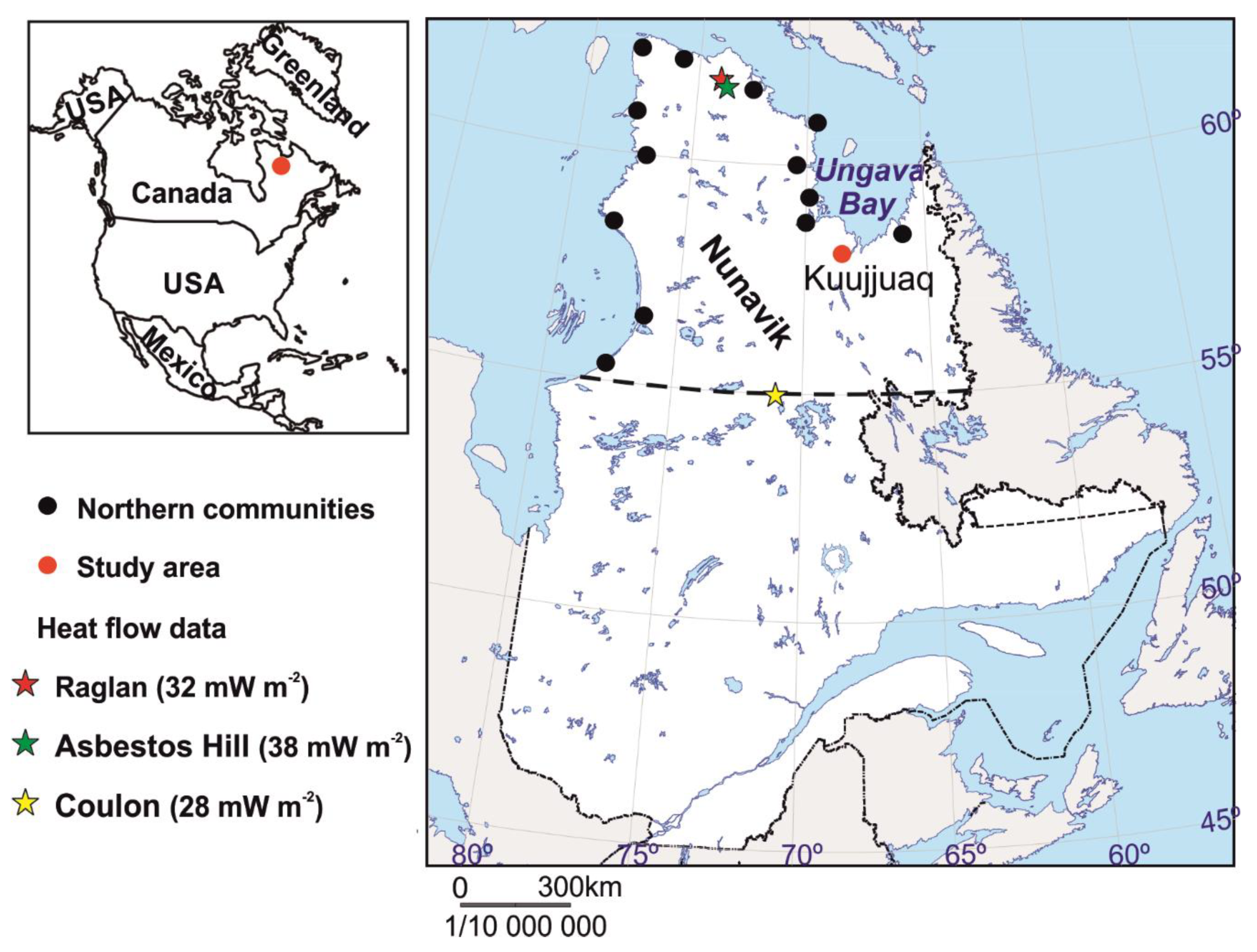
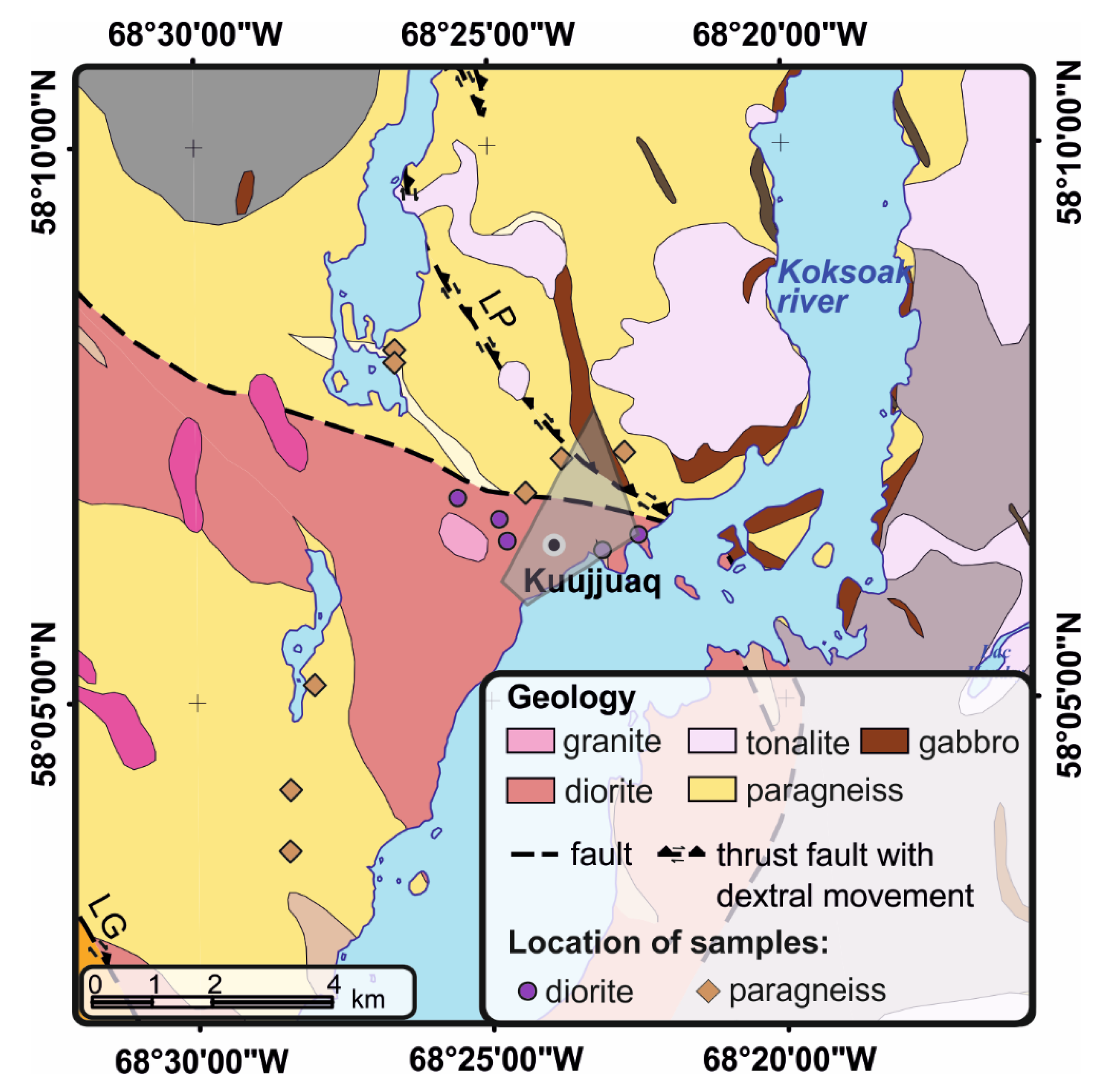

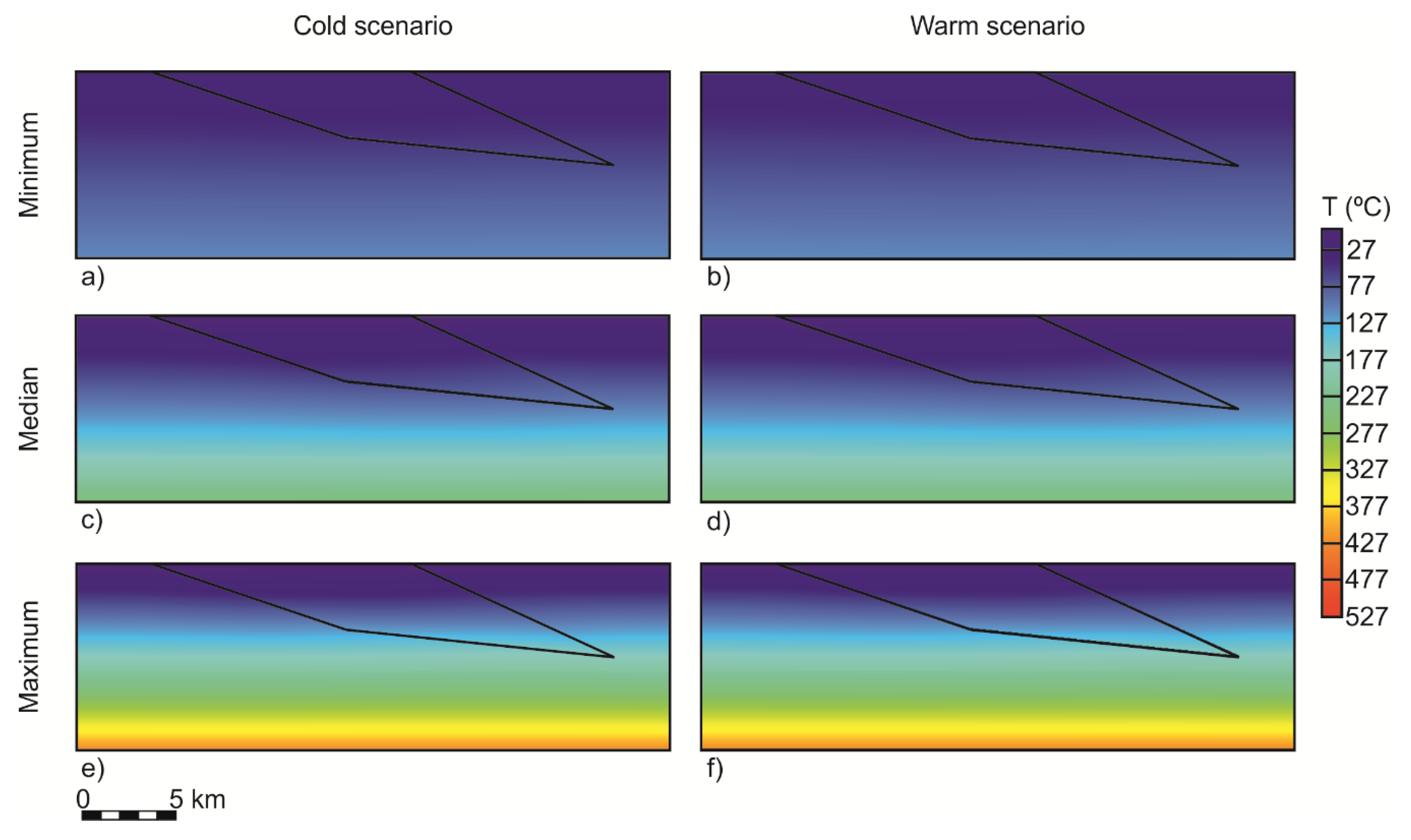
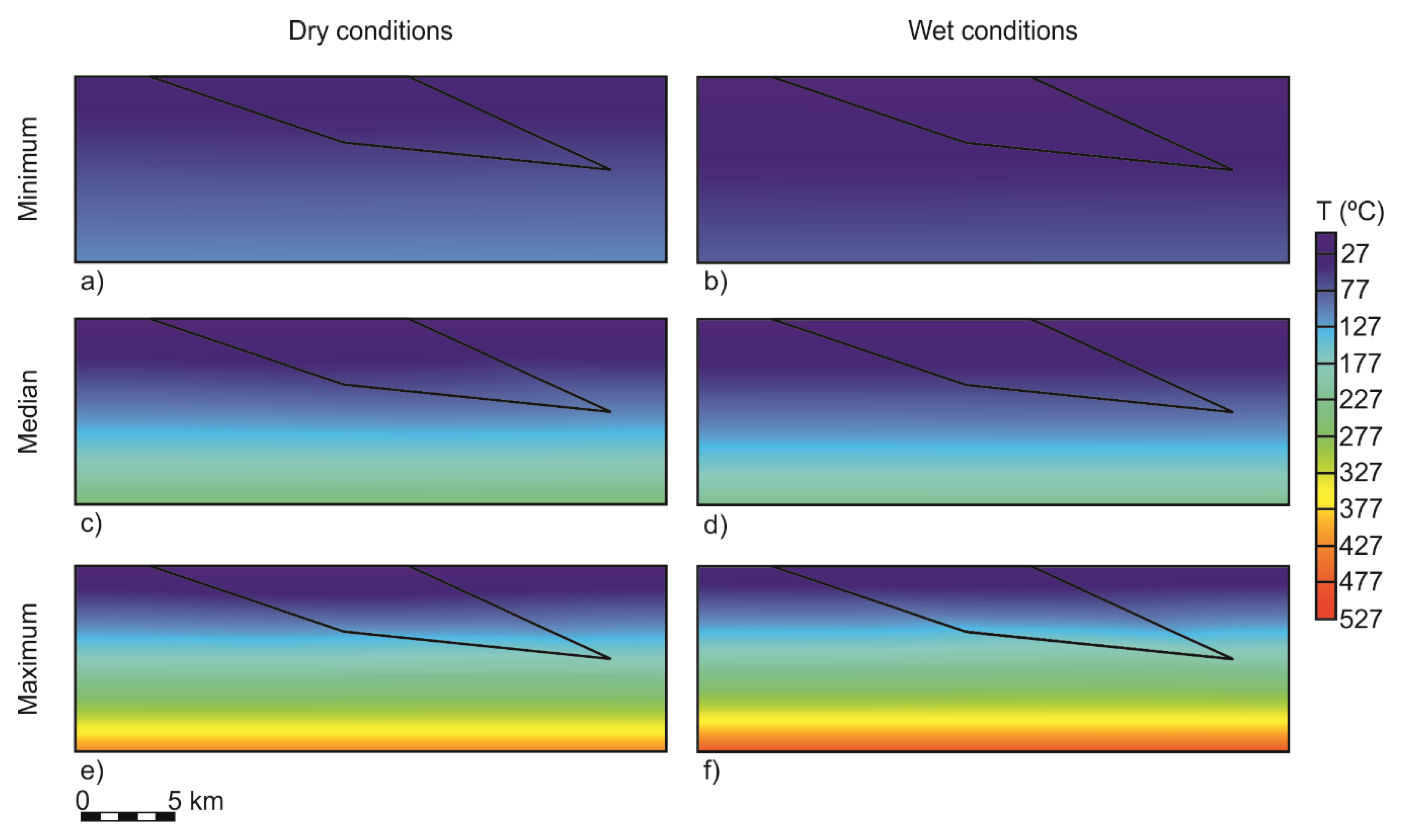

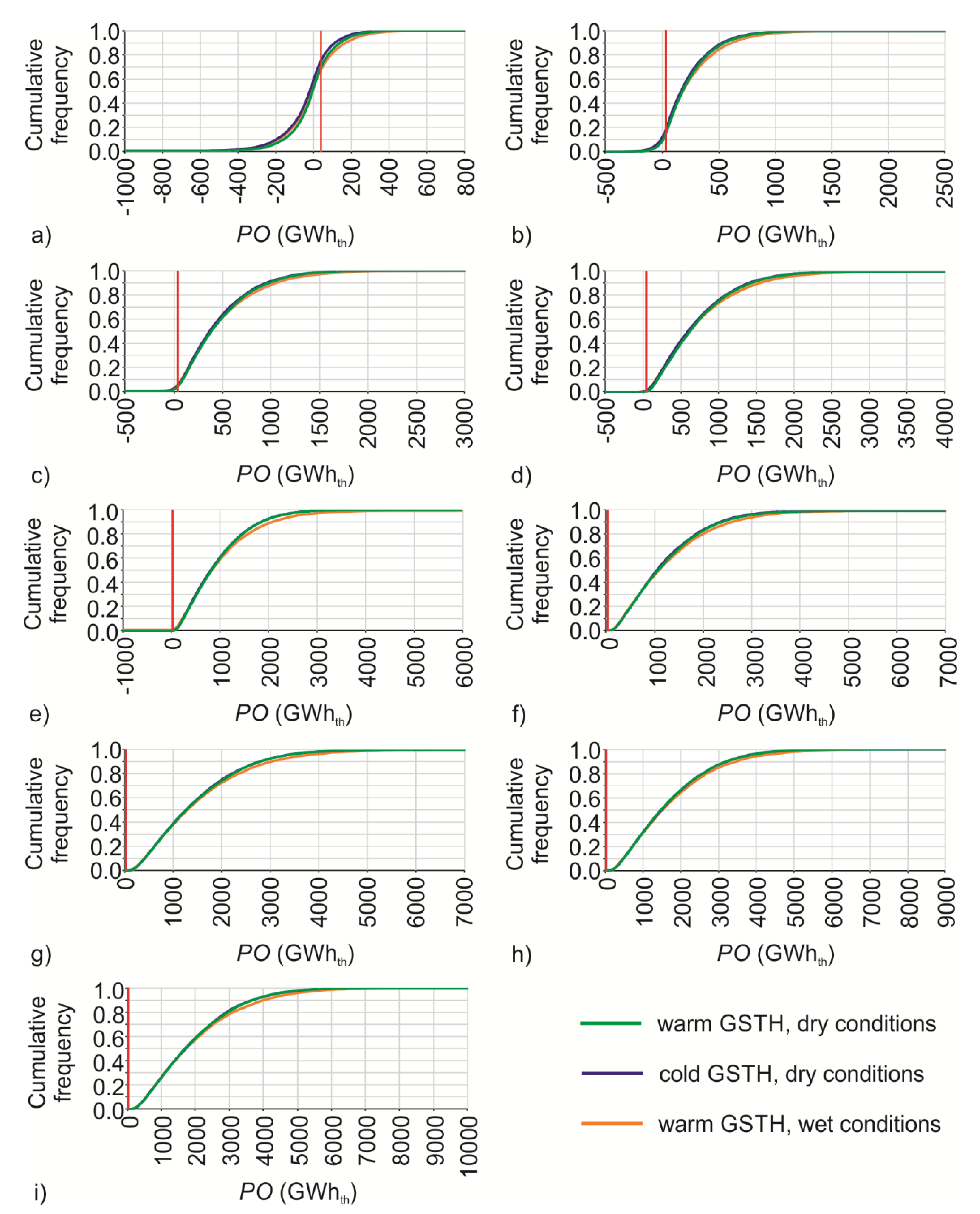
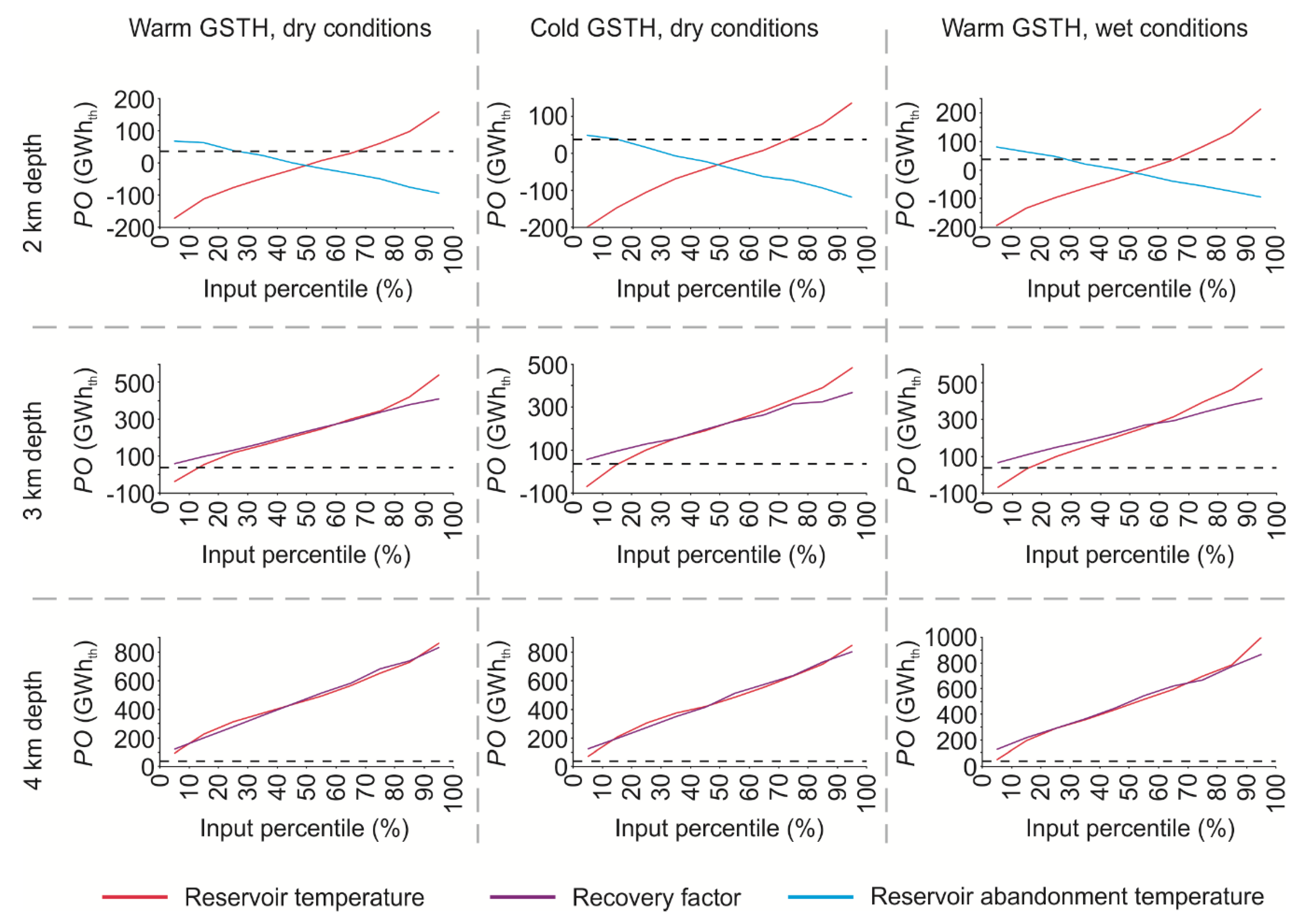


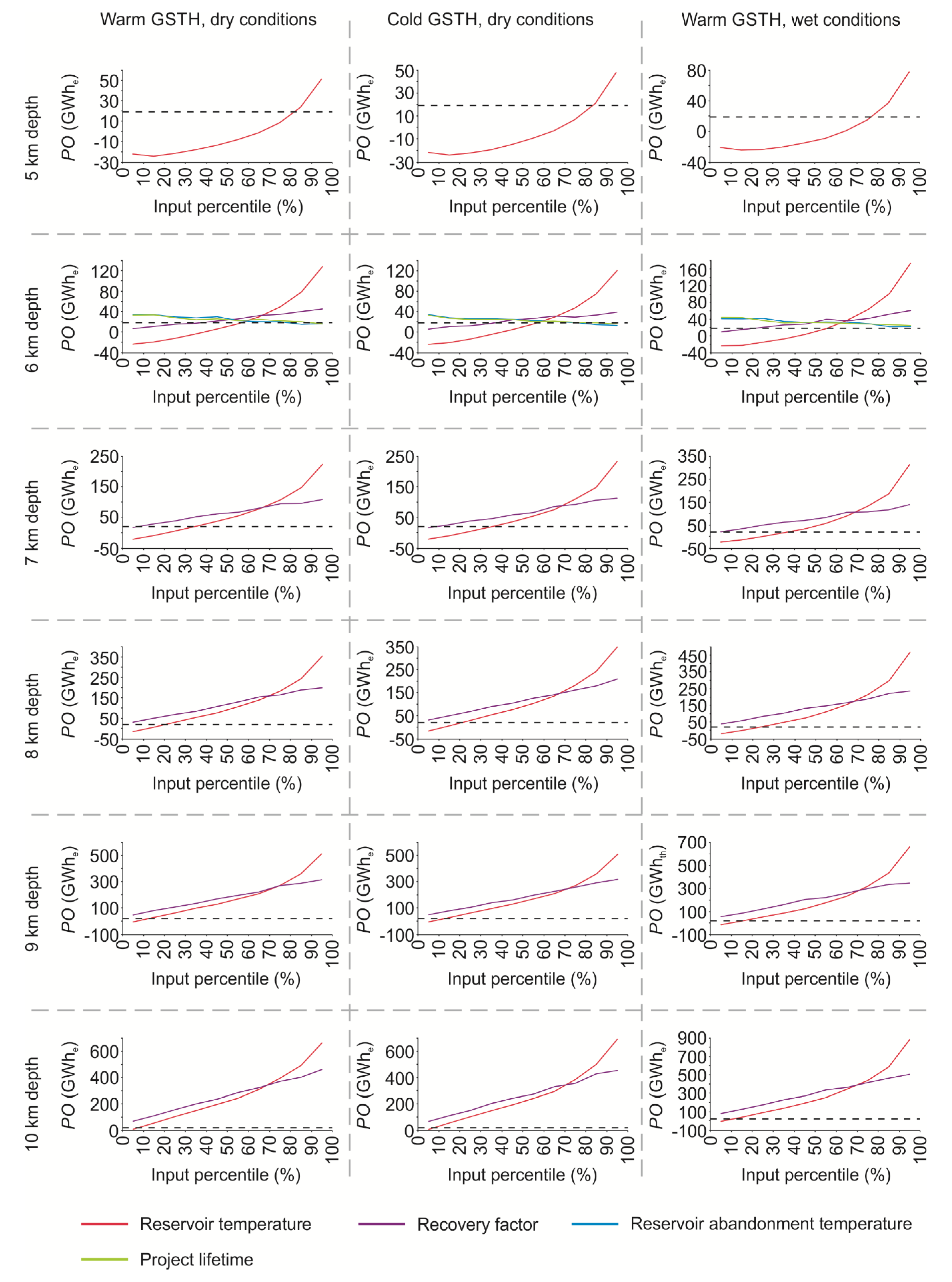
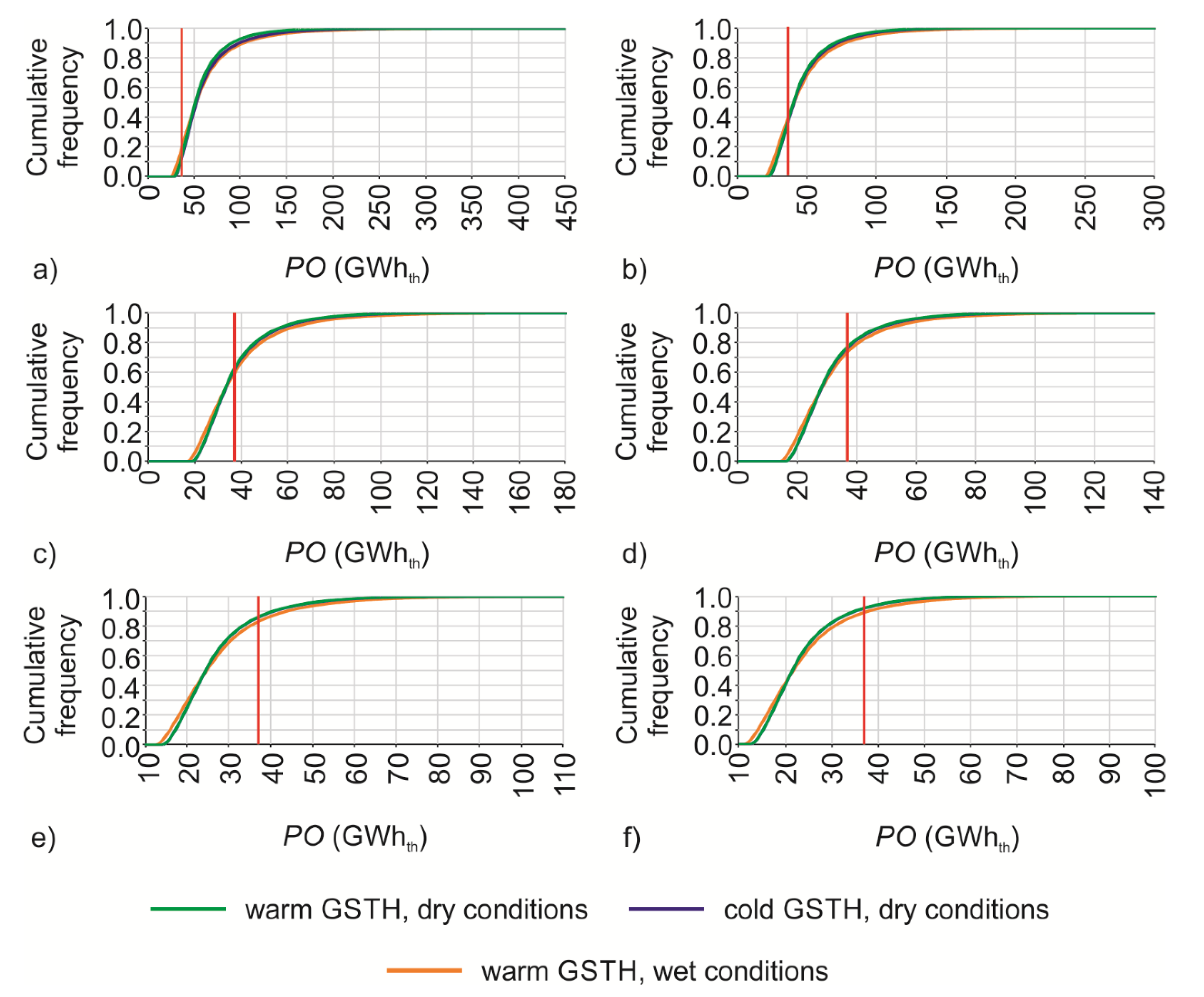
| Event | Time Step (Years B.P.) | Temperature Step (°C) | |
|---|---|---|---|
| Cold Scenario | Warm Scenario | ||
| Nebraskan (MIS 14 *) | 300,000–265,000 | −10 | −1 |
| Aftonian (MIS 13–11 *) | 265,000–200,000 | 0 | 0 |
| Kansan (MIS 10 *) | 200,000–175,000 | −10 | −1 |
| Yarmouth (MIS 9–7 *) | 175,000–125,000 | 0 | 0 |
| Illinoian (MIS 6 *) | 125,000–100,000 | −10 | −1 |
| Sangamonian (MIS 5 *) | 100,000–75,000 | 0 | 0 |
| Wisconsinan (MIS 4–2 *) | 75,000–11,600 | −10 | −1 |
| Holocene (MIS 1) | 11,600–present | ||
| Holocene thermal maximum | 7000–5800 | +2 | |
| Roman and Medieval warm periods | 3200–1000 | +1 | |
| Little Ice Age | 500–270 | −1 | |
| Pre-industrial and Industrial Revolution | 270–80 | +1.4 | |
| Present-day global warming | 30–present | +2 | |
| Parameter Code | Parameter Description | Variable Type | Distribution |
|---|---|---|---|
| Geological uncertainties | |||
| V | Reservoir volume | Single value | |
| Tres | Reservoir temperature | Continuous | Triang(min,median,max) |
| ρc | Volumetric heat capacity | Continuous | Normal(μ,σ) |
| Technical uncertainties | |||
| Tref | Reservoir abandonment temperature | Continuous | Uniform(min,max) |
| R | Recovery factor | Continuous | Uniform(min,max) |
| ηth | Cycle thermal efficiency | f(T) | |
| FGPP | GPP factor | Continuous | Uniform(min,max) |
| t | Project lifetime | Continuous | Triang(min,most,max) |
| Paragneiss | Diorite | |||
|---|---|---|---|---|
| Dry | Wet | Dry | Wet | |
| λ (W m−1 K−1) | ||||
| μ | 2.26 | 2.67 | 2.78 | 3.08 |
| α | 0.55 | 0.64 | 0.65 | 0.82 |
| χ | 2.10 | 2.84 | 2.60 | 2.82 |
| [min–max] | 1.62–3.15 | 1.95–3.95 | 2.12–3.98 | 2.08–4.54 |
| ρc (MJ m−3 K−1) | ||||
| μ | 2.36 | 2.44 | 2.32 | 2.36 |
| α | 0.10 | 0.18 | 0.14 | 0.12 |
| χ | 2.37 | 2.34 | 2.31 | 2.33 |
| [min–max] | 2.20–2.47 | 2.27–2.71 | 2.16–2.53 | 2.22–2.59 |
| A (μW m−3) | ||||
| μ | 1.08 | 0.53 | ||
| α | 0.59 | 0.41 | ||
| χ | 1.16 | 0.44 | ||
| [min–max] | 0.21–1.99 | 0.16–1.14 | ||
| Paragneiss | ||||||||
|---|---|---|---|---|---|---|---|---|
| λ(W m−1 K−1) | ||||||||
| T (°C) | 20 | 40 | 60 | 80 | 100 | 120 | 140 | 160 |
| μ | 2.32 | 2.28 | 2.22 | 2.11 | 2.05 | 1.95 | 1.88 | 1.63 |
| α | 0.63 | 0.63 | 0.66 | 0.66 | 0.76 | 0.72 | 0.71 | 0.63 |
| χ | 2.20 | 2.12 | 2.00 | 1.84 | 1.70 | 1.59 | 1.49 | 1.32 |
| [min–max] | 1.69–3.21 | 1.67–3.20 | 1.66–3.22 | 1.58–3.13 | 1.49–3.30 | 1.40–3.13 | 1.33–3.05 | 1.10–2.63 |
| λ(W m−1 K−1) | ||||||||
| P (MPa) | 2.8 | 4.8 | 6.2 | 10.3 | 20.7 | 34.5 | 48.3 | |
| μ | 2.32 | 2.32 | 2.33 | 2.34 | 2.40 | 2.43 | 2.44 | |
| χ | 2.15 | 2.16 | 2.17 | 2.19 | 2.22 | 2.25 | 2.26 | |
| [min–max] | 1.64–3.32 | 1.64–3.43 | 1.65–3.53 | 1.66–3.67 | 1.67–3.79 | 1.70–3.86 | 1.68–3.92 | |
| Paragneiss | ||||||||
|---|---|---|---|---|---|---|---|---|
| λ(W m−1 K−1) | ||||||||
| T (°C) | 20 | 40 | 60 | 80 | 100 | 120 | 140 | 160 |
| μ | 2.39 | 2.33 | 2.25 | 2.10 | 1.96 | 1.86 | 1.78 | 1.49 |
| α | 0.87 | 0.83 | 0.81 | 0.78 | 0.80 | 0.77 | 0.76 | 0.68 |
| χ | 2.58 | 2.57 | 2.53 | 2.36 | 2.24 | 2.12 | 2.02 | 1.70 |
| [min–max] | 1.41–3.73 | 1.39–3.60 | 1.30–3.42 | 1.18–3.16 | 1.01–2.91 | 0.94–2.75 | 0.87–2.67 | 0.68–2.33 |
| λ(W m−1 K−1) | ||||||||
| P (MPa) | 2.8 | 4.8 | 6.2 | 10.3 | 20.7 | 34.5 | 48.3 | |
| μ | 2.83 | 2.86 | 2.87 | 2.90 | 2.94 | 2.96 | 2.98 | |
| χ | 2.65 | 2.67 | 2.68 | 2.71 | 2.75 | 2.76 | 2.78 | |
| [min–max] | 2.13–4.10 | 2.14–4.11 | 2.15–4.12 | 2.16–4.16 | 2.17–4.23 | 2.17–4.29 | 2.18–4.33 | |
| Number of Elements | T (17,999, −4999.5) (°C) | Relative Difference (%) |
|---|---|---|
| 22 | 98.71 | - |
| 289 | 98.56 | −0.15 |
| 758 | 98.52 | −0.04 |
| 2223 | 98.53 | 0.01 |
| 8544 | 98.55 | 0.02 |
| 9750 | 98.55 | 0 |
| 13,725 | 98.55 | 0 |
| Depth (km) | Tmin (°C) | Tmedian (°C) | Tmax (°C) | |||
|---|---|---|---|---|---|---|
| Cold | Warm | Cold | Warm | Cold | Warm | |
| 0–1 | 1 | 5 | 13 | 13 | 19 | 22 |
| 1–2 | 10 | 15 | 38 | 38 | 62 | 65 |
| 2–3 | 20 | 24 | 63 | 63 | 105 | 107 |
| 3–4 | 30 | 33 | 88 | 88 | 148 | 150 |
| 4–5 | 39 | 42 | 113 | 113 | 191 | 193 |
| 5–6 | 49 | 52 | 137 | 137 | 234 | 235 |
| 6–7 | 59 | 61 | 162 | 162 | 277 | 278 |
| 7–8 | 68 | 70 | 187 | 187 | 320 | 321 |
| 8–9 | 78 | 79 | 212 | 212 | 363 | 363 |
| 9–10 | 88 | 89 | 237 | 237 | 406 | 406 |
| Depth (km) | Tmin (°C) | Tmedian (°C) | Tmax (°C) | |||
|---|---|---|---|---|---|---|
| Dry | Wet | Dry | Wet | Dry | Wet | |
| 0–1 | 5 | 5 | 13 | 12 | 22 | 25 |
| 1–2 | 15 | 12 | 38 | 34 | 65 | 72 |
| 2–3 | 24 | 20 | 63 | 57 | 107 | 120 |
| 3–4 | 33 | 28 | 88 | 79 | 150 | 167 |
| 4–5 | 42 | 36 | 113 | 102 | 193 | 215 |
| 5–6 | 52 | 43 | 137 | 124 | 235 | 262 |
| 6–7 | 61 | 51 | 162 | 147 | 278 | 310 |
| 7–8 | 70 | 59 | 187 | 169 | 321 | 358 |
| 8–9 | 79 | 67 | 212 | 191 | 363 | 405 |
| 9–10 | 89 | 74 | 237 | 214 | 406 | 453 |
| Depth (km) | Waste Heat (MWth) | CHP (GWhth) | |||||
|---|---|---|---|---|---|---|---|
| Warm GSTH, Dry | Cold GSTH, Dry | Warm GSTH, Wet | Warm GSTH, Dry | Cold GSTH, Dry | Warm GSTH, Wet | ||
| 5 | μ | 13 | 14 | 14 | 58 | 62 | 62 |
| σ | 6 | 7 | 8 | 26 | 32 | 37 | |
| [min–max] | 6–51 | 6–72 | 6–93 | 28–222 | 28–317 | 25–406 | |
| 6 | μ | 10 | 11 | 11 | 46 | 47 | 48 |
| σ | 4 | 5 | 6 | 19 | 21 | 25 | |
| [min–max] | 5–39 | 5–42 | 5–58 | 22–169 | 23–185 | 20–254 | |
| 7 | μ | 8 | 9 | 9 | 37 | 38 | 38 |
| σ | 3 | 4 | 4 | 15 | 16 | 19 | |
| [min–max] | 4–29 | 4–31 | 4–39 | 19–126 | 19–134 | 17–172 | |
| 8 | μ | 7 | 7 | 7 | 31 | 32 | 32 |
| σ | 3 | 3 | 3 | 12 | 13 | 15 | |
| [min–max] | 4–23 | 4–24 | 3–30 | 16–102 | 16–106 | 14–132 | |
| 9 | μ | 6 | 6 | 6 | 27 | 27 | 28 |
| σ | 2 | 2 | 3 | 10 | 10 | 13 | |
| [min–max] | 3–19 | 3–20 | 3–25 | 14–85 | 14–87 | 12–108 | |
| 10 | μ | 5 | 5 | 6 | 24 | 24 | 24 |
| σ | 2 | 2 | 2 | 9 | 9 | 11 | |
| [min–max] | 3–17 | 3–16 | 3–21 | 12–72 | 12–72 | 11–91 | |
© 2020 by the authors. Licensee MDPI, Basel, Switzerland. This article is an open access article distributed under the terms and conditions of the Creative Commons Attribution (CC BY) license (http://creativecommons.org/licenses/by/4.0/).
Share and Cite
Miranda, M.M.; Raymond, J.; Dezayes, C. Uncertainty and Risk Evaluation of Deep Geothermal Energy Source for Heat Production and Electricity Generation in Remote Northern Regions. Energies 2020, 13, 4221. https://doi.org/10.3390/en13164221
Miranda MM, Raymond J, Dezayes C. Uncertainty and Risk Evaluation of Deep Geothermal Energy Source for Heat Production and Electricity Generation in Remote Northern Regions. Energies. 2020; 13(16):4221. https://doi.org/10.3390/en13164221
Chicago/Turabian StyleMiranda, Mafalda M., Jasmin Raymond, and Chrystel Dezayes. 2020. "Uncertainty and Risk Evaluation of Deep Geothermal Energy Source for Heat Production and Electricity Generation in Remote Northern Regions" Energies 13, no. 16: 4221. https://doi.org/10.3390/en13164221




